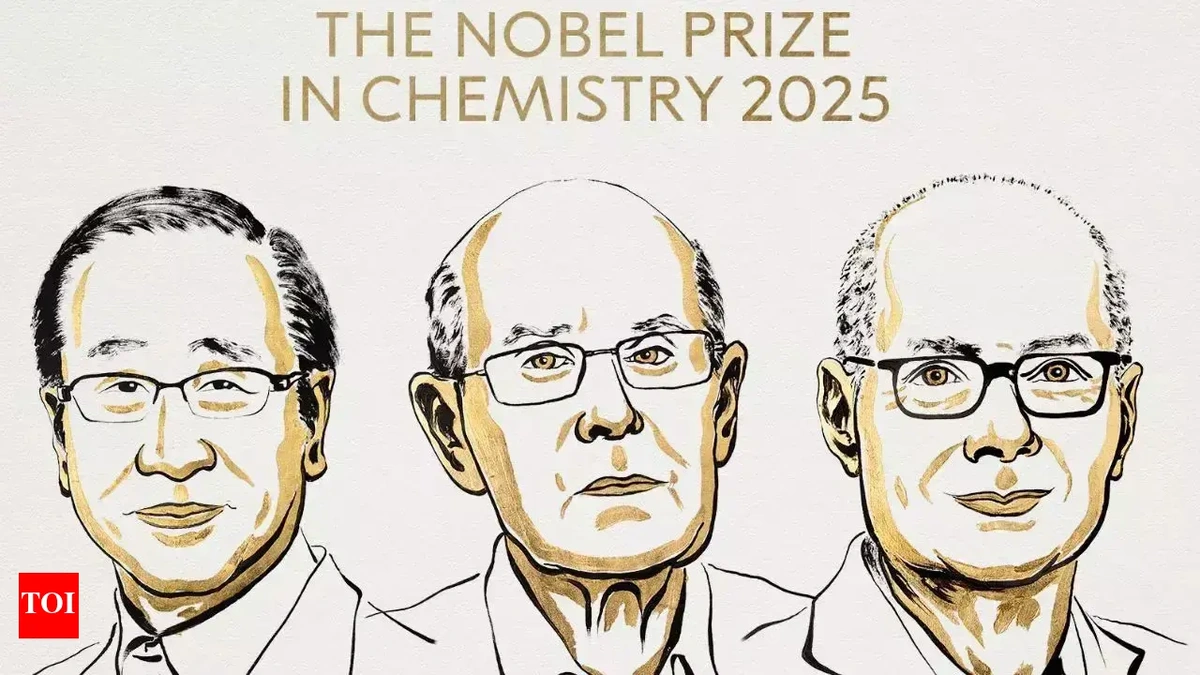The 2025 Nobel Prize in Chemistry has been awarded to Susumu Kitagawa, Peter Robson, and Omar M. Yaghi for their groundbreaking work on metal-organic frameworks (MOFs). But, here’s the thing, this isn’t just another science headline. This is a story about how incredibly tiny structures are poised to revolutionize everything from the air we breathe to the energy that powers our world. What fascinates me is how these scientists turned theoretical concepts into tangible, transformative realities.
What Exactly Are Metal-Organic Frameworks?

Okay, let’s break it down. Imagine tiny, perfectly organized cages built from metal ions and organic molecules. These are MOFs. They’re porous, meaning they have incredibly high surface areas. Think of it like this: a single teaspoon of MOFs could have the surface area of a football field! It sounds like science fiction, right? But it’s not – it’s chemistry genius at work.
But, why does that matter ? Well, these porous structures can trap specific molecules. Imagine a filter that can selectively capture carbon dioxide from the atmosphere, or a sponge that soaks up dangerous pollutants. That’s the power of MOFs. Wikipedia , has a good explanation of the technical bits if you are interested.
The ‘Why’ Behind the Buzz | Solving Real-World Problems
So, the Nobel Prize in Chemistry isn’t just about recognizing clever science; it’s about celebrating solutions to some of humanity’s biggest challenges.
Let’s be honest: climate change is a monster. We need innovative ways to reduce carbon emissions. MOFs offer a promising avenue for carbon capture and storage. Instead of releasing CO2 into the atmosphere, we can trap it within MOFs and potentially reuse it or store it safely.
But it doesn’t stop there. MOFs also hold huge potential for:
- Gas Storage: Think safer and more efficient storage of hydrogen for fuel cells, or natural gas for vehicles.
- Water Harvesting: Imagine pulling potable water straight from the air in arid regions.
- Drug Delivery: MOFs can encapsulate drugs and release them slowly and precisely within the body.
- Catalysis: Speeding up chemical reactions to make industrial processes more efficient and sustainable.
The Pioneers | Kitagawa, Robson, and Yaghi
Susumu Kitagawa, Peter Robson, and Omar M. Yaghi each brought unique expertise to the field. Here’s a simplified look:
- Susumu Kitagawa: Pioneered the design and synthesis of MOFs with a focus on gas adsorption and separation.
- Peter Robson: Made key contributions to the understanding of MOF structure and properties.
- Omar M. Yaghi: Introduced the concept of reticular chemistry, which allows for the rational design of MOFs with specific functions.
Their collaborative work has laid the foundation for countless applications. It’s like they provided the building blocks, and now scientists around the world are using them to construct amazing new technologies.
From Lab to Life | The Future of MOFs
Okay, this is where it gets really exciting. MOFs are no longer just a laboratory curiosity. Companies are already exploring their use in various applications. For example, there are projects underway to use MOFs in air purifiers, water filters, and even in the development of new batteries.
I initially thought this was straightforward, but then I realized the true potential lies in the scalability of MOF production. If we can manufacture them cheaply and efficiently, we can deploy them on a massive scale to address global challenges. A common mistake I see people make is underestimating the potential impact of materials science.
The impact of MOFs on various chemical processes is immense. Incredible, isn’t it ?
So What does this Nobel Mean for India?
India, with its growing population and increasing industrial footprint, faces significant challenges related to pollution, water scarcity, and energy security. MOFs offer potential solutions in several key areas:
- Air Quality: MOFs could be used in air purification systems to remove pollutants from urban environments.
- Water Purification: They can filter out contaminants and provide access to clean drinking water.
- Sustainable Agriculture: MOFs can be used to deliver fertilizers and pesticides more efficiently, reducing environmental impact.
- Energy Storage: They can enhance the performance of batteries and fuel cells, supporting the transition to renewable energy sources.
The Indian scientific community is already actively involved in MOF research. This Nobel Prize will likely spur even greater interest and investment in the field, leading to the development of homegrown MOF-based technologies.
FAQ About Nobel Prize in Chemistry and MOFs
Frequently Asked Questions
What are the main applications of MOFs?
MOFs have applications in gas storage, carbon capture, water harvesting, drug delivery, and catalysis.
How do MOFs help with carbon capture?
MOFs have high surface areas that allow them to selectively trap carbon dioxide from the atmosphere.
Who are the scientists awarded the 2025 Nobel Prize in Chemistry?
Susumu Kitagawa, Peter Robson, and Omar M. Yaghi were awarded the prize for their work on metal-organic frameworks.
What is reticular chemistry?
It is a concept introduced by Omar M. Yaghi that allows for the rational design of MOFs with specific functions.
What is metal-organic frameworks(MOFs)?
Metal-organic frameworks are tiny, porous structures built from metal ions and organic molecules, having extremely high surface areas for trapping molecules.
Ultimately, the 2025 Nobel Prize in Chemistry isn’t just an award; it’s a signal. It’s a beacon shining on a field of science that holds immense promise for a more sustainable and prosperous future. And, let’s be honest, that’s something worth celebrating.




